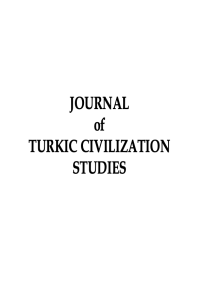PROTEST MOVEMENTS IN KAZAKSTAN AND CENTRAL ASIA IN 1916: SOME THEORETICAL AND METHODOLOGICAL PROBLEMS
Öz
1916 events form the concluding stage of the protest movements of the Kazak people against the Russian colonization in Kazakstan and Central Asia. The year of 1916 was accepted as “terrible” and “scarifying” by some historiographers of Kazakstan. Interestingly enough, the events of 1916 are assessed sometimes as “uprising”, “war” and even “revolution”. This paper focuses on the determining some theoretical and methodological problems for better understanding the national liberation movements in Kazakstan and Central Asia in 1916-1917. Besides, there are some suggestions for studying this topic fruitfully.
Kaynakça
- Грозный 1916 год. Сборник документов и материалов. – Алматы: Казахстан, 1998. – Т.1. – С.347.
- Ақкөз батыр. – Алматы, Қазақпарат, 2001.
- С.А. Асанова, Ислам в духовной культуре Казахстана начала века. – В кн. Казахстан в начале ХХ века: методология, историография, источниковедение. Выпуск 2. – Алматы, 1994. - С. 81.
Öz
1916 events form the concluding stage of the protest movements of the Kazak people against the Russian colonization in Kazakstan and Central Asia. The year of 1916 was accepted as “terrible” and “scarifying” by some historiographers of Kazakstan. Interestingly enough, the events of 1916 are assessed sometimes as “uprising”, “war” and even “revolution”. This paper focuses on the determining some theoretical and methodological problems for better understanding the national liberation movements in Kazakstan and Central Asia in 1916-1917. Besides, there are some suggestions for studying this topic fruitfully.
Anahtar Kelimeler
Kaynakça
- Грозный 1916 год. Сборник документов и материалов. – Алматы: Казахстан, 1998. – Т.1. – С.347.
- Ақкөз батыр. – Алматы, Қазақпарат, 2001.
- С.А. Асанова, Ислам в духовной культуре Казахстана начала века. – В кн. Казахстан в начале ХХ века: методология, историография, источниковедение. Выпуск 2. – Алматы, 1994. - С. 81.
Ayrıntılar
| Birincil Dil | Rusça |
|---|---|
| Konular | İletişim Çalışmaları |
| Bölüm | Araştırma Makalesi |
| Yazarlar | |
| Yayımlanma Tarihi | 30 Haziran 2006 |
| Yayımlandığı Sayı | Yıl 2006 Cilt: 2 Sayı: 1 |
Journal of Turkic Civilization Studies © 2022 by TUAUM is licensed under Attribution-NonCommercial 4.0 International
Journal of Turkic Civilization Studies by TUAUM is licensed under Attribution-NonCommercial 4.0 International


